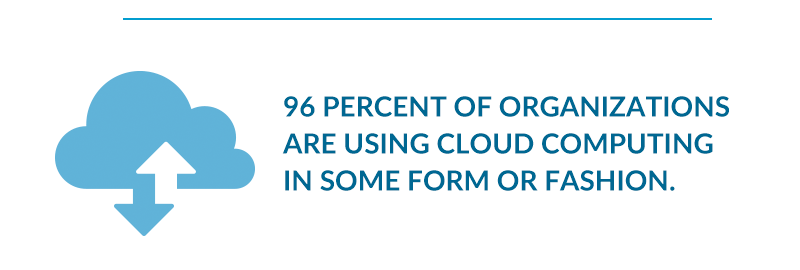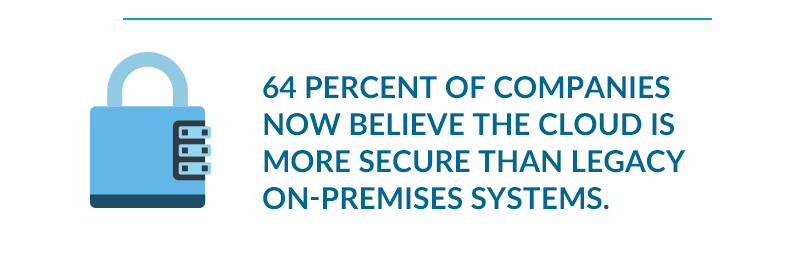Yet while 53 percent of corporate data is now stored in the cloud, a great deal of information still remains in on-premises data centers. One reason for the reluctance to move more data into the cloud is concerns about IT security. According to a 2018 survey, nine out of ten cybersecurity professionals report they’re still troubled by cloud security issues, including questions of data loss and breaches. However, while some degree of caution is prudent, the public cloud is actually more secure than an on-premises data center.
According to Gartner, "Through 2020, public cloud infrastructure as a service (IaaS) workloads will suffer at least 60% fewer security incidents than those in traditional data centers." Let’s cover 5 reasons why the public cloud is more secure than alternative options, and in the process, bust some of the most common cloud myths and misconceptions.
1. Greater technical expertise
Unless your company is already in the business of IT security, spending time and effort on securing your on-premises data distracts from your core functions. Most organizations likely don’t have a robust, experienced team of cybersecurity professionals at their disposal to properly protect their on-premises data.
When 73 percent of businesses admit they’re not prepared for a cyberattack, how can they continue to believe that their information is secure on-premises?
Public cloud providers have made it their company mission to give customers the cloud storage and services they need to function as a business. Their profitability and reputation depend on ensuring that customers’ data remains secure within the cloud. As such, cloud providers may employ hundreds or thousands of developers and IT professionals. And here at Eplexity, every engineer is AWS Certified. We strive to deliver secure, innovative, and affordable AWS cloud services and solutions, so you don't have to spend valuable resources securing your environment.
Related Content: 4 public cloud trends to watch for
2. Physical separation
Concerns about cloud security often overlook one of the most important vectors of attack on IT resources: physical access. Being in close proximity to a computer system makes it significantly easier for a malicious actor to launch a successful attack.
Because on-premises data centers are usually located within or close to the enterprise itself, your network is at risk of physical access by unauthorized users, especially insider threats who work for your organization.
On the other hand, data in the cloud may be stored on a server physically located anywhere in the world, making a physical attack much less likely. What’s more, top public cloud providers will protect these servers with defenses such as fences, guards, biometric devices, and security cameras. This is precisely why the cloud is more secure than an on-premise data center.
3. Fewer vulnerabilities
For many businesses, storing your files on-premises feels subconsciously “safer” because the information is physically closer to their location. However, this is largely a quirk of human psychology that doesn’t apply well to the realities of cybersecurity.
When it comes to protecting your enterprise data, the physical location matters less than the means of access—who is able to view and use the information that’s been stored on the server. This means that attackers’ main goal is to find and capitalize on existing vulnerabilities.
Malicious actors have many different ways of exploiting these flaws in on-premise systems, from unpatched security holes to phishing emails that seek to collect your employees’ passwords. The top public cloud providers are quick to fix these issues to keep your data protected. They may even have “white hat” hackers on their payroll whose job is to find vulnerabilities before the attackers do.
Related Content: How next-gen MSPs are keeping customers safe
4. Better resiliency
Natural disasters such as hurricanes, tornadoes, and wildfires illustrate just how fragile data can be when backed up on-premises. Keeping information in a nearby physical location means that backups are much less effective, if not entirely useless.
Part of cybersecurity is ensuring that data is available and protected as much as possible. Using a public cloud provider to back up your information makes it much more likely that you can rebound from unexpected catastrophes. For example, in two years between 2015 and 2017, Amazon Web Services experienced a total of only 7.5 hours of downtime.
Can your IT department guarantee that your systems will have less than 7.5 hours of downtime next month, let alone for the next two years? Most IT departments can't. Here at Eplexity, we're an AWS Advanced + partner, dedicated to selecting the best cloud computing solution for your specific circumstances. It doesn't matter if you're new to the cloud or you're experienced in the cloud but could use some assistance, we're here to help.
5. Newer technologyhttps://eplexity.com/cloud-strategy/
Because they’ve been built up over a period of years, many on-premises data centers are a hodgepodge of aging legacy tech. This makes them a nightmare to maintain and secure due to the difficulties of reconciling all these disparate systems, some of which are no longer supported or updated.
The top public cloud providers avail themselves of the latest technology in order to give their customers more computing resources. This also makes cloud data centers easier to support, maintain, and patch.
Related Content: The top 4 benefits of a managed cloud service provider
Next Steps - Migrating to the Cloud
If security is one of the issues that's keeping you from migrating to the cloud, we encourage you to read the current research and see how the benefits of the public cloud can help your business. From security to cost to scalability to speed, migrating to the public cloud is will enable you to focus your IT resources on higher value business driven projects.






